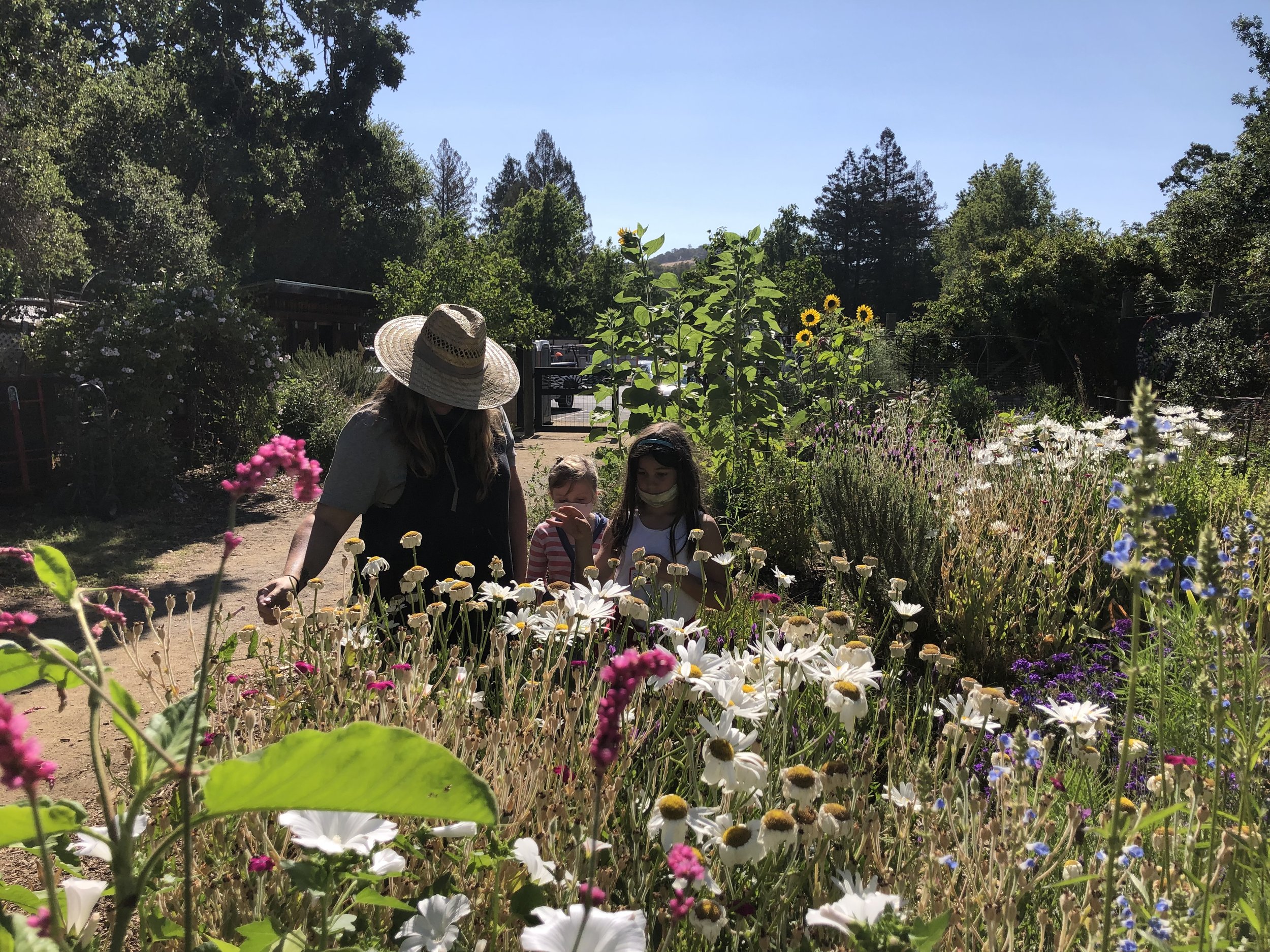Small Wins Build Momentum for Big Changes
School Sustainability Champion Bio: In 1994—when sustainability was still an emerging concept in education—Shelley Flint joined San Domenico School in San Anselmo, California. Over the past 20+ years as Sustainability Director, she has transformed sustainability from small-scale projects into a core pillar of the school’s identity. San Domenico offsets 85% of its energy consumption through renewables (and working to expand this to 95%!), and its school culture actively fosters stewardship, environmental literacy, and a deep appreciation for the natural world.
Beginnings
Although sustainability had long been a core value at San Domenico School, it lacked a clear, actionable framework. When Shelley Flint arrived over twenty years ago, the head of school told her, “These ideas are very abstract. We support them, we agree with them, but we need you to make them concrete for our school.” That challenge became her launching point.
Tasked with transforming broad sustainability principles into tangible practices, Shelley recalls her early days: “I remember being handed a crate of ancient files and having to find an office somewhere just to figure it all out.” Fortunately, the school’s teachers had already laid a foundation, setting initial sustainability goals that helped guide her work.
Shelley structured her approach around four key areas: curriculum, campus operations, garden management, and watershed stewardship. She started with waste, energy, and water audits, establishing a baseline for San Domenico’s sustainability journey—one that would eventually evolve into a model of environmental leadership.
A Living Classroom: The School Garden as a Hub of Learning and Community
At San Domenico School, the acre-sized garden is more than just a place to grow food—it’s an interactive classroom, a community gathering space, and a vibrant hub for hands-on learning. Shelley has worked to ensure that students are immersed in every aspect of the growing process, from planting and harvesting to preparing and enjoying the food. “Kids aren’t just growing food—they’re part of the whole process,” she shared. “They tend to the soil, plant seeds, harvest crops, and make meals—it’s all about making learning hands-on.”
San Domenico’s gardens are not only a special place for students to connect with nature - they provide important habitats for pollinators too!
A key ingredient in the garden’s success has been its outdoor kitchen, which brings the experience full circle. “If anyone has a school garden, I’d say the best way to build excitement is to have a kitchen,” Shelley advised. “The kids love the food, and the garden naturally becomes a meeting place for everyone—a true community space.” It’s not uncommon to see multiple grade levels working together, whether tending to the gardens, cooking, or participating in schoolwide celebrations.
From garden to table: The outdoor kitchen at San Domenico has been a huge hit with students.
One of the most anticipated events of the year is the Garden Fair, where students from K-12 create and sell products made from the garden’s harvest. “We do a lot of canning, fermenting, and even making natural body care products,” Shelley explained. The event transforms the garden into a bustling marketplace, complete with beautifully packaged student-made goods, live music, games, and festivities.
The garden also plays a role in schoolwide gatherings, hosting everything from parent community events to student celebrations. Through this hands-on approach, San Domenico’s garden has become a model for integrating sustainability, education, and community engagement—one that continues to inspire students and families alike.
Revamping the School’s Food System: From Disposable to Sustainable
Beyond the garden, Shelley has also helped to transform the school’s food service system. When she first arrived, school meals were heavily reliant on disposable packaging—plastic-wrapped foods, individual pudding cups, and single-use utensils. Recognizing the need for a shift, she helped transition to Epicurean, a provider that better aligned with the school’s sustainability values. Today, hot lunches are served on washable plates with reusable utensils, and at least 40% of the food is organic—a significant departure from the plastic-wrapped meals of the past. Through these initiatives, Shelley has embedded sustainability into both the culture and daily operations of San Domenico.
A key part of making this shift successful was investing in the right infrastructure. “We were fortunate enough to already have a kitchen in place to accommodate washing reusable dishes making it an easier transition to eliminate disposables. I would recommend schools looking to reduce lunch waste to invest in kitchen infrastructure if they can. Working with our cafeteria staff we organized clearly labeled stations with color coded waste bins- (green for compost, another for landfill waste)creating an easy to follow process where students scrape their leftover food into the compost bin and place their plates in the collection buckets.”
San Domenico now has a fully staffed cafeteria, a lunch line, and two dishwashing stations to handle the volume of reusable plates and utensils. To streamline waste separation, Shelley helped design a simple, student-friendly system:
Clearly labeled stations with buckets for plates, forks, and cups
Color-coded waste bins—green for compost, another for landfill waste
Easy-to-follow process where students scrape their leftover food into the compost bin and place their plates in collection buckets
“If you can set up multiple of these waste stations around, it makes it seamless for students,” Shelley shared.
Beyond logistics, shifting school culture was just as important. Shelley spent time building relationships with the food service director and kitchen staff, carefully introducing alternative models. “It’s a delicate walk,” she noted. “You don’t want to be critical—you want to approach it with curiosity and collaboration. My best advice is to form a fun, kind relationship with your maintenance and food service directors before you even bring ideas to the table.”
Thanks to these efforts, hot lunches are now served on washable plates with reusable utensils, and at least 40% of the food is organic—a significant departure from the plastic-wrapped meals of the past. Through a thoughtful blend of infrastructure, collaboration, and cultural shift, Shelley has embedded sustainability into both the daily operations and ethos of San Domenico.
Solar: From the Swimming Pool to School-Wide Energy
When Shelley Flint set out to bring solar power to San Domenico School, she quickly realized that an immediate, large-scale solar project wasn’t realistic. “Clearly, we weren’t just going to jump right in and get this huge solar system,” she recalled. Instead, she looked for a strategic entry point—a project that would demonstrate a clear return on investment and build momentum for future initiatives.
The perfect opportunity presented itself with the school's swimming pool. “One of the best applications for solar is solar thermal heating on a pool—it’s an easy win with a quick payback,” Shelley explained. With minimal upfront costs (around $20,000 at the time), the project was low-hanging fruit that was easy to justify financially. “It was kind of a no-brainer,” she added. “Because the payback was so obvious, they said, ‘Okay, let’s do it.’”
The solar thermal panels were installed on a plot of land near the pool, and their success paved the way for larger solar initiatives. To expand beyond small projects, Shelley helped the school transition to a power purchase agreement (PPA), which allowed a third-party company to install, own, and maintain the solar system while San Domenico benefited from renewable energy without upfront costs. “They own the system, they take care of it, and basically, we’re just leasing our land in a way—but we still get the benefits,” Shelley explained. “They get to put up their panels, we get solar power—it’s a win-win.”
Thanks to this strategic approach, solar now provides 85% of the school’s energy needs, with an expansion in progress to reach 95% renewable energy.
Lessons in Building a Sustainable School
Shelley’s approach to sustainability at San Domenico School has been project-driven, focusing on small, tangible wins that built momentum over time. “If you can focus on one project and make it successful, that builds energy, and you can keep going from there,” she explained. This incremental strategy helped embed sustainability into the school’s culture—not as a mandate, but as a natural part of daily operations.
Her journey also underscored the importance of building strong relationships with key stakeholders, including the maintenance team, food service directors, and finance department. “
“Adding a financial perspective with measurable payback reinforces your case,” Shelley noted. While financial viability is crucial, she also learned that framing sustainability in terms of its broader benefits—such as student engagement, health, and environmental impact—was just as important in gaining support for long-term change.
Key Lessons:
Start with Small Wins: Begin with manageable projects that have clear benefits to build momentum for larger sustainability initiatives.
Make Abstract Concepts Concrete: Translate broad sustainability ideas into specific, actionable steps that align with the school's operations and curriculum.
Persistence Pays Off: Stay determined, even when facing challenges or a steep learning curve, as persistence can lead to significant long-term gains.
Build Relationships with Key Stakeholders: Establish strong connections with maintenance, food service, and finance directors to ensure sustainability projects are supported and successful.
Integrate Sustainability into the School Culture: Gradually incorporate sustainability practices so they become a natural part of the school's culture, rather than imposed mandates.
Leverage Hands-On Learning: Create learning spaces, like school gardens, that engage students directly with sustainability, fostering a sense of community and practical understanding.
Frame Projects Beyond Financials: While financial returns are important, also highlight the broader benefits of sustainability projects, such as environmental impact and educational value (and even improving the school brand!)
Continuous Improvement: Sustainability is an ongoing process—focus on building success through continuous, project-driven efforts.
Through passion, patience and persistence, Shelley Flint has helped to transform sustainability from an aspiration to a reality at San Domenico School, California.
Did you know…
Schools can now use START: Sustainability Tracking, Analytics & Roadmap Tool to:
access a step-by-step framework for holistic school sustainability across Educational Programs, Organizational Culture & Physical Place
establish their Whole School Sustainability Baseline
analyze & track energy, waste, water & emissions data
Did you know…
You can find toolkits and resources for building your school garden in the START Community > #7: Outdoor Learning Environments.
Did you know…
You can find ideas for school sustainability events in the START Community > #1: Events.
Did you know…
You can find toolkits and resources for ditching disposables in the START Community > #46: Tableware & Trays.
Did you know…
79% of solar-powered schools use third-party financing, such as (PPAs), to reduce or eliminate installation expenses. A solar power purchase agreement (PPA) is a financial arrangement where a third-party developer installs, owns, and maintains a solar energy system on a property, while the host (e.g., a school) purchases the generated electricity at a fixed, often lower rate. This allows the school to benefit from solar power without the upfront costs of purchasing and installing the system.
Shelley Flint’s impact goes beyond greening the school—by connecting students with nature, she’s shaping lifelong attitudes toward sustainability and stewardship.







